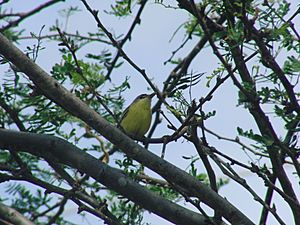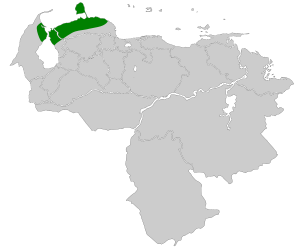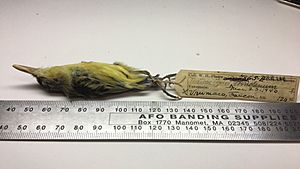Maracaibo tody-flycatcher facts for kids
Quick facts for kids Maracaibo tody-flycatcher |
|
|---|---|
 |
|
| Conservation status | |
| Scientific classification | |
| Genus: |
Todirostrum
|
| Species: |
viridanum
|
 |
|
The Maracaibo tody-flycatcher (Todirostrum viridanum) is a small, colorful bird. It is sometimes called the short-tailed tody-flycatcher. This special bird belongs to the Tyrannidae family, which is a group of birds often called "tyrant flycatchers."
This bird is only found in one specific place on Earth! It lives in the dry, bushy areas near Lake Maracaibo in Venezuela. When a plant or animal lives only in one place, we say it is endemic to that area.
Contents
About the Maracaibo Tody-Flycatcher
The Maracaibo tody-flycatcher is a unique bird. It was first described in 1927 by a scientist named Carl Edward Hellmayr. For a while, some people thought it was just a type, or subspecies, of the common tody-flycatcher. However, scientists now agree it is its own distinct species.
What Does It Look Like?
Like other tody-flycatchers, this bird is quite small. It has a short tail and a flattened bill, which is perfect for catching insects. Its bright colors help it blend in with the plants where it lives.
Where Does It Live?
This bird loves the dry, scrubby lands around Lake Maracaibo. This area has special plants and a warm climate that the Maracaibo tody-flycatcher needs to survive. It finds food and builds its nest among the bushes and small trees.
Protecting This Special Bird
Unfortunately, the Maracaibo tody-flycatcher is facing some challenges. Its home, the arid scrubland, is slowly disappearing.
Why Is Its Home Disappearing?
The biggest threat to this bird is habitat loss. This means that the places where it lives are being changed or destroyed. People might clear land for farming, build new towns, or develop industries. When this happens, the birds lose their homes, their food sources, and safe places to raise their young.
What Can Be Done?
Protecting the Maracaibo tody-flycatcher means protecting its habitat. Conservation groups and scientists are working to understand more about this bird and its needs. By protecting the unique scrublands of Venezuela, we can help ensure that this little bird continues to fly free for many years to come.
See also
 In Spanish: Titirijí de Maracaibo para niños
In Spanish: Titirijí de Maracaibo para niños



